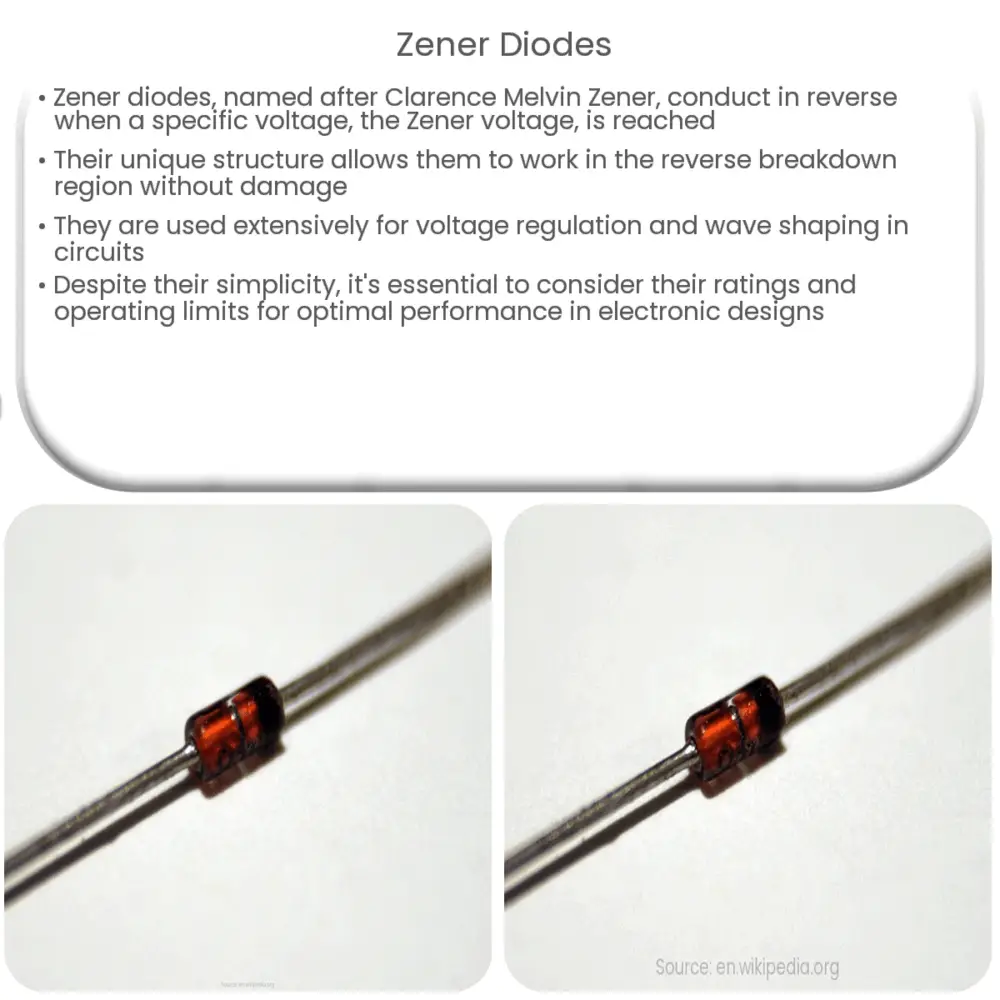Explore the world of Zener Diodes – their structure, unique properties, applications, ratings, and best practices for circuit integration.

Zener Diodes: An Introduction
Zener diodes, named after their inventor Clarence Melvin Zener, are a special type of semiconductor diode with a unique attribute: they can conduct in the reverse direction when a specific voltage, known as the Zener voltage, is reached.
Structure and Functioning
The structure of a Zener diode resembles that of a standard PN junction diode, but it has a drastically narrower and more heavily doped depletion region. This configuration permits it to perform in the reverse breakdown region without any damage, which is a distinguishing characteristic of Zener diodes.
When a forward bias is applied to the Zener diode, it behaves like a standard diode, allowing current to flow from its anode to its cathode. When a reverse bias is applied and the applied voltage reaches the Zener voltage, however, the diode ‘breaks down’ and allows current to flow in the reverse direction.
Applications of Zener Diodes
- Voltage Regulation: Zener diodes are extensively used for voltage regulation in various circuits. They keep the output voltage constant even if the input voltage or load current changes.
- Wave Shaping: In wave shaping circuits, Zener diodes are used to modify waveforms. They can clip off portions of signals to shape them as desired.
Properties of Zener Diodes
The distinct properties of Zener diodes stem from their unique structure and functioning:
- Zener Voltage (VZ): This is a critical parameter of Zener diodes. It is the reverse breakdown voltage after which the diode allows current to flow in the reverse direction.
- Power Dissipation: This is the amount of power (in watts) the Zener diode can dissipate into the surrounding environment without overheating. It is directly related to the diode’s physical size.
Zener diodes are an invaluable component in many electronic circuits. Their unique ability to breakdown without damage and control voltage variations make them ideal for a variety of applications, from voltage regulation to waveform shaping. These humble components, despite their simplicity, play a significant role in ensuring the smooth operation of electronic devices around us.
Zener Diode Ratings
Like other electronic components, Zener diodes also come with certain ratings that define their operating limits. Two key ratings are:
- Zener Test Current (IZT): This is the current at which the Zener voltage is measured. It varies with the diode’s power rating and the Zener voltage.
- Maximum Zener Impedance (ZZM): This is the maximum AC impedance at a specified test current (IZT).
Zener Diodes in Practice
When integrating a Zener diode into a circuit, one needs to ensure that the diode operates within its specified power limits. If the power dissipation exceeds the rating, the diode could be damaged due to overheating. Therefore, it’s crucial to connect a resistor in series with the diode to limit the current flowing through it.
Choosing the Right Zener Diode
When selecting a Zener diode for a specific application, one must consider the required Zener voltage, the maximum power dissipation, and the current handling capacity. Also, environmental factors such as ambient temperature and circuit layout can influence the diode’s performance and should be considered.
Conclusion
In conclusion, Zener diodes are versatile electronic components that play a critical role in regulating voltage and shaping waveforms in a wide variety of applications. They are named after Clarence Melvin Zener, who contributed to their development and our understanding of their unique reverse breakdown property.
Despite their relative simplicity, Zener diodes require careful consideration when integrating into a circuit. Attention to their ratings and operating limits is crucial to ensure optimal performance and prevent damage. Whether you are designing a voltage regulation circuit or a waveform shaping circuit, the humble Zener diode will likely be an indispensable part of your design.

